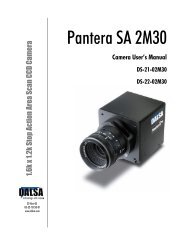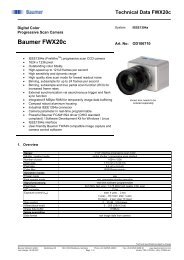TR-33 TR-34 TR-35 Trillium Rhino User's Manual - Frame Grabbers
TR-33 TR-34 TR-35 Trillium Rhino User's Manual - Frame Grabbers
TR-33 TR-34 TR-35 Trillium Rhino User's Manual - Frame Grabbers
You also want an ePaper? Increase the reach of your titles
YUMPU automatically turns print PDFs into web optimized ePapers that Google loves.
<strong>Trillium</strong> User’s <strong>Manual</strong> 47<br />
T RILLIUM U SER’ S M ANUAL<br />
Appendix A: EIA-644 Reference<br />
EIA-644 is an electrical specification for the transmission of digital data. The<br />
standard is available from the EIA (Electronic Industries Association). It defines<br />
voltage levels, expected transmission speeds over various cable lengths, common<br />
mode voltage operating requirements for transmitters and receivers, and input<br />
impedances and sensitivities for receivers. The table below gives a quick<br />
comparison between EIA-644 and RS422 (another differential standard).<br />
Table 2. RS422 vs. EIA-644<br />
Parameter RS422 EIA-644<br />
Differential Driver Output Voltage ±2-5V ±250-450mV<br />
Receiver Input Threshold ±200mV ±100mV<br />
Data Rate 400Mbps<br />
Supply Current, Quad Driver (no load, static)* 60mA 3.0mA<br />
Prop. Delay of Driver, max.* 11ns 3ns<br />
Prop. Delay of Receiver, max.* 30ns 5ns<br />
Supply Current, Quad Receiver (no load, static)* 23mA 10mA<br />
* based on National Semiconductor DS90C031/2<br />
The standard requires that two wires (e.g. twisted pair) be used to transmit one<br />
signal in a differential mode. This means that one wire will be logic HIGH while<br />
the other wire is logic LOW. Voltage swing between HIGH and LOW is<br />
approximately <strong>35</strong>0mV, with a typical offset of approximately 1.25V. The use of<br />
differential signal transmission allows the receiver to reject common mode<br />
voltages. This noise rejection improves data integrity and allows cameras to be<br />
installed in an industrial environment.<br />
EIA-644-compatible line receivers and drivers are available from many different<br />
IC manufacturers in a variety of fabrication technologies such as CMOS and<br />
GaAs. The EIA-644 standard does not define specific voltages, so it can migrate<br />
from 5V power supplies to 3.3V and sub-3V. DALSA recommends the use of 5V<br />
CMOS line drivers and receivers such as National Semiconductor parts<br />
DS90C031 quad line driver and DS90C032 quad line receiver.<br />
DALSA 03-32-10119-03
















